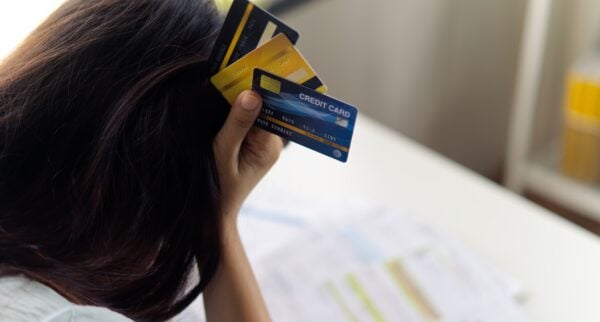
Credit card debt plagues many Americans, keeping them from achieving their financial goals. Several resources are available to assist people in paying off debt, each with its own pros and cons. Debt forgiveness is one such tool, but it’s not for everyone, nor is it a quick fix. If you’re wondering how credit card debt forgiveness works, it’s important to avoid certain myths that may keep you from pursuing other money goals.
What is credit card debt forgiveness?
Credit card debt forgiveness is when you settle your accounts for less than the amount owed. In effect, the issuing bank cancels a portion of the indebtedness, allowing you to become debt-free sooner. Additionally, it enables the credit card company to receive something rather than the prospect of nothing.
The key in pursuing debt forgiveness is the ability to prove financial hardship, such as job loss or other unexpected events. You probably won’t qualify if you’re simply a month or two behind on payments.
Common myths about debt forgiveness
There are a lot of misconceptions surrounding the forgiveness of credit card debt. You may see advertisements promoting the possibility of writing off the entirety of your debt or that you must pay onerous fees to start.
Debt is often a challenge for many Americans, so it’s essential to know the difference between truth and what may make the process more painful. Here are some common debt forgiveness myths to avoid.
You can’t negotiate it yourself
A quick internet search reveals numerous companies that can assist in debt forgiveness. Working with a company is unnecessary if you prefer to go at it alone. “Typically the best benefits a debt settlement company offers are the knowledge of what a creditor might accept and the structure of holding your funds in an escrow account. Typically, it is significantly more cost-effective to settle the debts yourself,” says Ashley Morgan of Ashley F. Morgan Law. If you prefer a DIY approach, contact the creditor to begin the process of managing it yourself.
It’s a quick fix
Wiping your slate clean quickly is an appealing thought. Unfortunately, credit card debt forgiveness is rarely a fast solution. Each situation is different, and settling debt often takes time and negotiation. You must follow the guidelines of the agreement, which can take time.
It will ruin your credit
A common fear around debt forgiveness is that it will irreparably hurt your credit. That’s simply not the case on most occasions. “Although the account may show up on your credit report as settled, which can shave points off your credit score, in most cases, people who pursue this option already have bad credit… And if the forgiven part helps you get back on your financial feet so you can use credit products but also pay on time and keep balances to zero, you can get ahead pretty quickly,” says Erica Sandberg, consumer finance and debt expert at BadCredit.org.
It’s for everyone
Credit card debt forgiveness isn’t a one-size-fits-all solution. It’s primarily for Americans in truly dire circumstances, such as those with missed payments for extended months or job loss. Those with small balances or the ability to make minimum payments are unlikely to qualify.
It’s always the best option
Seemingly a mirage in the middle of a desert, debt forgiveness isn’t always the best choice for everyone. It can be a valuable resource, but other tools may help you achieve your goals more quickly. Don’t overlook the reality of tax liability either if the amount forgiven is over $600.
Smart alternatives to debt forgiveness and proactive steps
Credit card debt forgiveness may be an appealing way to reduce indebtedness. That’s not always true. Here are some wise alternatives that can help provide better chances of relief.
Budgeting: Whenever debt is troublesome, assessing your budget is key. “If you can increase your income a bit and decrease your expenses a bit, you can make a difference in paying off debt,” says Morgan. This won’t work for everyone, but identifying several hundred dollars a month to throw at debt can make a significant difference.
Balance transfer cards: These are best for people with good credit who may need to reduce interest. Balance transfer cards can offer a 0% APR for up to 21 months, allowing you to focus on the principal. Fees of up to 5% are possible, and you must repay within the promotional period or risk being charged interest on the entire balance.
Bankruptcy: While seemingly odd, bankruptcy may be a better choice compared to debt forgiveness. “Depending on the situation, discharging the balances in a Chapter 7 bankruptcy may be the preferred response to overwhelming debt,” notes Sandberg. Bankruptcy can provide a fresh beginning in the right situation, allowing you to achieve goals sooner.
Debt consolidation: Getting a loan to consolidate debt can be a better fit in the right circumstances. Making payments on the loan can also help improve your credit score. Due diligence is key, so consult the National Foundation for Credit Counseling or ask your local bank to identify good options. Don’t forget one of the more common debt consolidation myths that you have to pay exorbitant fees to start.
Frequently asked questions about credit card debt forgiveness
You may wonder, ‘Is credit card debt forgiveness real?’ and still have questions about the process. Here are some common questions people have when considering the possibility of debt forgiveness.
Does debt forgiveness hurt your credit?
Yes, debt forgiveness can damage your credit, but it’s important to know every situation is different. If you already have bad credit, you may not see a significant impact. Moreover, if the amount of forgiveness helps you get back on solid ground, you can make good headway in boosting your score.
Who qualifies for credit card debt forgiveness?
Credit card debt forgiveness isn’t for everyone. For people merely behind a month or two on payments, or those who can manage minimum payments, it will be difficult to qualify. Debt forgiveness is typically an option only for those facing financial hardship or considering bankruptcy.
Is debt forgiveness a scam?
No, not all debt forgiveness is a sham. There are reputable resources that can help get you back on your feet. Perform due diligence to find a firm that can help, and beware of companies that require payment upfront. “Requiring fees before they actually do the work is a definite no-no,” says Sandberg.
How do you receive credit card debt forgiveness?
You can pursue credit card debt forgiveness by directly negotiating with your credit card issuer for a reduced lump-sum payment or a hardship plan. Alternatively, debt settlement companies can negotiate on your behalf, but they often come with fees and risks to your credit. Non-profit credit counseling agencies offer debt management plans, which focus on making the debt more manageable through lower interest rates, rather than outright forgiveness.
The bottom line on credit card debt forgiveness
Debt is often a struggle for many Americans, and it can feel like it’s impossible to break the shackles and achieve freedom. Eliminating high-interest debt is possible, and credit card debt forgiveness is a tool to make that a reality. Make sure it’s a fit for you, and beware of red flags before pursuing it as a solution.


